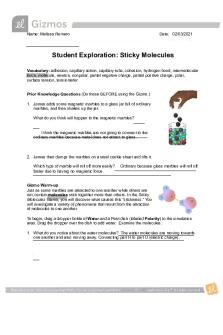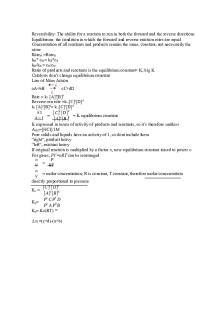Chemistry Sticky Notes PDF

| Title | Chemistry Sticky Notes |
|---|---|
| Course | Chemistry |
| Institution | Higher School Certificate (New South Wales) |
| Pages | 2 |
| File Size | 43.2 KB |
| File Type | |
| Total Downloads | 52 |
| Total Views | 127 |
Summary
notes from chemistry made throughout class in year 11 and 12 ...
Description
Chemistry
1. equation n= m/mm
n= c x v
C1V1 = C2V2
n= v/mv
work on limiting and excess reagents (do practice questions)
- alpha particle releases 2 protons and 2 neutrons (a helium nucleus) - beta particle is an electron
in chemical reactions, reactants combine in fixed definite propoirtions (or ratios) to form products. PRIMARY STANDARD polar and non-polar
- Allotropes are different structural forms of the same element whereas isotopes are different nuclear compositions of the same element in terms of neutrons. Examples of allotropes include carbon in the form of graphite or diamond and isotopes of carbon all have the same number of protons and electrons but different numbers of neutrons eg Carbon12 has 6 neutrons but Carbon14 has 8 neutrons.
Cycads have been a traditional source of food for Aboriginal and Torres Strait Islander peoples. Justify the procedure that is used for safe consumption of cycads. Cycads contain two main toxins which are Cycasin and beta-methylamino-Lalanine or BMAA. Cycasin is a known carcinogen and BMMA a neurotoxin. So these toxins had to be removed. Both these molecules are polar, hence, water soluble. The cycads were soaked in water for up to two weeks in reed woven baskets. This helped remove the water soluble toxins making the cycads safe for consumption.
A catalyst is a chemical substance that increases the rate of a chemical reaction by taking an alternate pathway which has a lower activation energy. Therefore, a greater proportion of reactant particles would have more energy than the lower activation energy, resulting in successful collisions. Eg rhodium-platinum catalyst is required for the manufacture of nitric acid using the Ostwald process.
Describe the two main factors that affect the stability of an isotope. Refer to elements in your response.
The two main factors that affect the stability of an isotope are mass of the nucleus and the ratio of neutrons to protons in the nucleus.
All nuclei with an atomic number greater than 83 are unstable. These nuclei contain too many protons and neutrons and this results in their instability. They tend to emit an alpha particle which reduces the number of protons and neutrons by two.
The ratio of neutrons to protons in the nucleus needs to be considered for elements with atomic number less than 83. If the ratio of neutrons to protons is too high or too low, the nucleus may be unstable.
Elements with an atomic number less than 20 tend to have approximately equal numbers of protons and neutrons and the neutron to proton ratio is close to one. If their ratio is not equal to one then the nucleus will be unstable and radioactive....
Similar Free PDFs

Chemistry Sticky Notes
- 2 Pages

Sticky Molecules Sehandin
- 8 Pages

Sticky Molecules- Gizmos Answers
- 7 Pages

Gizmo- Sticky Molecules
- 7 Pages

Chemistry Lecture Notes
- 8 Pages

Chem1101 - Mastering Chemistry Notes
- 32 Pages

Organic Chemistry Study Notes
- 37 Pages

Module 7 Chemistry Notes
- 63 Pages

ALL Notes - Organic Chemistry
- 45 Pages

Ch01 - organic chemistry notes
- 36 Pages

Document - Chemistry recap notes
- 35 Pages

Module 8 Chemistry Notes
- 33 Pages

Analytical Chemistry Notes
- 2 Pages
Popular Institutions
- Tinajero National High School - Annex
- Politeknik Caltex Riau
- Yokohama City University
- SGT University
- University of Al-Qadisiyah
- Divine Word College of Vigan
- Techniek College Rotterdam
- Universidade de Santiago
- Universiti Teknologi MARA Cawangan Johor Kampus Pasir Gudang
- Poltekkes Kemenkes Yogyakarta
- Baguio City National High School
- Colegio san marcos
- preparatoria uno
- Centro de Bachillerato Tecnológico Industrial y de Servicios No. 107
- Dalian Maritime University
- Quang Trung Secondary School
- Colegio Tecnológico en Informática
- Corporación Regional de Educación Superior
- Grupo CEDVA
- Dar Al Uloom University
- Centro de Estudios Preuniversitarios de la Universidad Nacional de Ingeniería
- 上智大学
- Aakash International School, Nuna Majara
- San Felipe Neri Catholic School
- Kang Chiao International School - New Taipei City
- Misamis Occidental National High School
- Institución Educativa Escuela Normal Juan Ladrilleros
- Kolehiyo ng Pantukan
- Batanes State College
- Instituto Continental
- Sekolah Menengah Kejuruan Kesehatan Kaltara (Tarakan)
- Colegio de La Inmaculada Concepcion - Cebu


